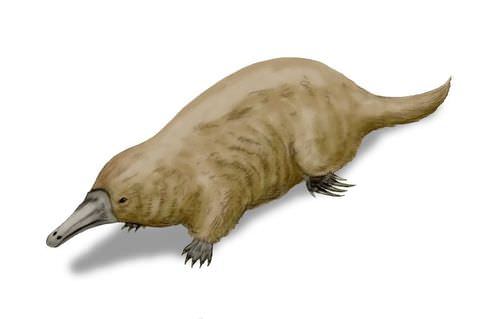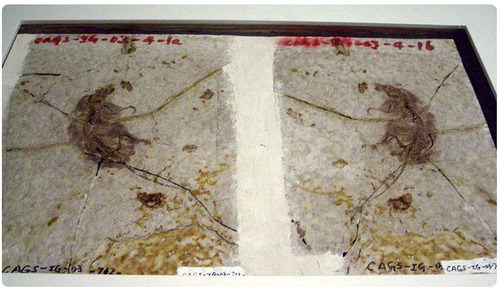16.46哺乳动物的演变 -- -- 高级
章节大纲
-
Could you argue that the duckbilled platypus has some characteristics of other ?
::你能辩称 鸭嘴白种人有其他的特征吗?Like a or a ? You could. This might suggest that an ancestor of this species may have been one of the early mammals to evolve.
::比如说一个还是一个?你可以。这或许可以说明 这个物种的祖先 可能是早期进化的哺乳动物之一。Mammalian Evolution
::Mammalian 进化Once mammals emerged from a cynodont ancestor, they continued to evolve and become more like modern mammals. mammals probably diverged from other mammals about 150 million years ago. Somewhat later, the first and appeared.
::哺乳动物从一个细胞系祖先诞生后,它们继续进化,更像现代哺乳动物。哺乳动物可能与其他哺乳动物在大约1.5亿年前不同。后来,第一种哺乳动物出现了。The Monotreme Divergence
::单体差异The monotreme lineage probably diverged from other early mammals shortly after the start of the Cretaceous Period. The earliest known monotreme represent the genus Teinolophos, which lived in Australia almost 125 million years ago. Another early monotreme genus, Steropodon , dates back about 110 million years ago and is also from Australia. Steropodon is believed to be an early relative of the platypus and, like the platypus, probably had a bill (see Figure ).
::在白鲸期开始后不久,单体动物的血统可能与其他早期哺乳动物不同。最早已知的单体动物代表了近1.25亿年前生活在澳大利亚的恶性原体。另一个早期的单体动物,Steropodon, 大约在1.1亿年前就已出现,也来自澳大利亚。 Steropodon被认为是白昼的早期相对者,与白昼一样,可能还有一张账单(见图 ) 。This early monotreme mammal belonged to the genus Steropodon and is believed to be an ancestor of the platypus. It lived during the Cretaceous Period, about 110 million years ago. These early monotremes retained some of the traits of earlier therapsid ancestors—traits that that are still found in modern monotremes but not in other mammals. These traits include an interclavicle in the shoulder girdle and by egg laying. Other modern monotreme traits—including the presence of a cloaca and a lack of nipples—have not been found preserved in fossils. Therefore, scientists can only assume that the earliest monotremes probably had these traits as well.
::这些早期的单体保留了早期狂野祖先的一些特征,这些特征仍然存在于现代单体动物中,但在其他哺乳动物中则没有发现。 这些特征包括肩带和卵子中的一种杂质。 其他现代单体特征 — — 包括木薯和乳头的缺乏 — — 还没有在化石中找到。 因此,科学家只能假设最早的单体也存在这些特征。Evolution of Marsupial Mammals
::哺乳哺乳动物的进化Recent phylogenetic analyses of molecular data from modern mammals suggest that marsupial mammals diverged from other mammals between 130 and 150 million years ago. However, until recently, no marsupial fossils had been found that were this old. The most ancient monotreme fossils came from about 110 milllion years ago and were represented by just a few teeth and jaw fragments. More complete fossils of marsupials were known only from about 90 to 65 million years ago.
::最近对现代哺乳动物分子数据进行的植物遗传分析表明,在1.3亿到1.5亿年前,哺乳动物与其他哺乳动物不同。然而,直到最近,还没有发现如此古老的哺乳动物化石。 最古老的单石化石来自大约110万年前的110万年前,只有几颗牙齿和下巴碎片代表。 更完整的哺乳动物化石仅在9 000万到6 500万年前才知道。Then, in 2003, a remarkable marsupial fossil was found in China. Given the genus name Sinodelphys , it is believed to have lived about 125 million years ago. The fossil is remarkable because it is a nearly complete specimen, as shown in Figure . Tufts of hair and imprints of soft tissues were even preserved. Sinodelphys was probably about 15 centimeters long and about 30 grams in weight. Its limb structure suggests that it was a climbing , which may account for its success. It would have been able to take refuge from predators by climbing into trees. Scientists speculate that Sinodelphys probably lived on a diet of and worms.
::而在2003年,中国发现了一种非凡的麻黄素化石。根据基因名称Sinodelphys,据信它已经活了大约1.25亿年前。化石之所以引人注目,是因为如图所示,它是一个几乎完整的样本。毛发和软组织印迹的图示甚至得到了保存。中黄素大概有15厘米长,体重约30克。它的四肢结构表明它是一个攀升,可以说明它是否成功。它本来可以通过爬入树木来躲避捕食者。科学家推测,中黄素可能生活在一种饮食和蠕虫上。The dark shapes on these two rock slabs are two halves of the fossil named Sinodelphys. The head is at the top of the image and the legs point toward the center. Evolution of Placental Mammals
::胎盘哺乳动物的演变The earliest known ancestor of eutherian mammals belongs to the extinct genus Eomaia , which is shown in Figure . Like Sinodelphys, Eomaia lived 125 million years ago in what is now China and was apparently a tree climber. However, Eomaia was even smaller. It was only about 10 centimeters long and probably weighed less than 25 grams.
::已知食用哺乳动物最早的祖先属于灭绝的埃奥马亚人,如图所示。与西诺德菲植物一样,尤马亚在1.25亿年前生活在现在的中国,显然是爬树者。然而,尤马亚甚至更小,只有大约10厘米长,可能体重不到25克。The genus Eomaia was comprised of small mammals that may have been ancestral to placental mammals. Eomaia had numerous traits of the teeth and bones that are found in eutherian mammals. However, the narrowness of the hips of the Eomaia fossil suggests that it gave birth to young that were very small. This indicates that gestation was short and suggests that the placenta had not yet fully evolved. Therefore, Eomaia was probably not a placental mammal, but it is a likely ancestor of placental mammals. These intermediate features are consistent with recent phylogenetic analyses of molecular data that suggest the placentals diversified about 110 million years ago, or about 15 million years after the date of the Eomaia fossil.
::Eomaia的牙齿和骨头有许多在化石哺乳动物体内发现的特征,然而,埃奥马亚化石的臀部狭小表明它产下的是非常小的年轻人。这表明妊娠时间短,表明胎盘尚未完全发育。因此,Eomaia可能不是胎盘哺乳动物,但它可能是胎盘哺乳动物的祖先。这些中间特征与最近对分子数据进行的植物遗传分析是一致的,这些分析表明胎盘在约1.1亿年前即约1500万年的埃奥马化石化石日期之后就多样化了。Marsupial and Placental Mammals in Australia
::澳大利亚的马苏比和胎盘哺乳动物Early placental mammals were generally more successful than early marsupial mammals. On most continents, placental mammals became the dominant mammals and marsupials died out. Only in Australia were marsupials the most numerous and diverse mammals. Until recently, paleontologists thought that marsupials were successful in Australia only because placental mammals did not reach the continent until about 5 million years ago, when rodents from Asia made their way to Australia.
::早期胎盘哺乳动物通常比早期的哺乳哺乳动物更成功,在大多数大陆,胎盘哺乳动物成为主要哺乳动物,哺乳动物死亡,只有澳大利亚的哺乳动物是数量最多、种类最多的哺乳动物。 直到最近,古生物学家一直认为,胎盘哺乳动物在澳大利亚之所以成功,只是因为胎盘哺乳动物直到大约500万年前才到达该大陆,当时来自亚洲的鼠类才来到澳大利亚。Paleontologists recently discovered the fossil of a possible placental mammal that lived in Australia about 115 million years ago. It was given the genus name Ausktribosphenos. Although this early mammal went extinct, it calls into question the hypothesized late arrival of placental mammals in Australia. Some scientists suggest that, if placentals were present there earlier, marsupials must have been able to outcompete them. They speculate that the slightly lower body temperature of marsupials would have taken less energy to maintain and may have been an adaptive advantage.
::白龙学家最近发现了一种可能胎盘哺乳动物的化石,它大约在1.15亿年前就生活在澳大利亚。它被命名为“Ausktribospenos ” 。 虽然早期哺乳动物已经灭绝,但它质疑胎盘哺乳动物晚到澳大利亚的假设规模。一些科学家认为,如果胎盘早些出现,则胎盘一定能够比它们更相容。他们推测,稍微低一点的体温会用较少的能量来维持并可能是一种适应优势。The Late Cretaceous Mass Extinction
::过时的白鲸群落灭绝At the close of the Cretaceous Period, about 65 million years ago, dinosaurs and most other species of large animals went extinct. Scientists think that this was due to the impact of a huge asteroid slamming into what is now the Yucatán Peninsula of Mexico. The force of the impact is estimated to have been two million times greater than the most powerful nuclear bomb ever tested. Debris from the impact would have blocked sunlight from reaching Earth’s surface and hindered all over the planet.
::在大约6500万年前的白鲸期结束时,恐龙和大多数其他大型动物物种都灭绝了。 科学家们认为,这是因为一个巨大的小行星撞入墨西哥现在的尤卡坦半岛。 撞击力估计比有史以来最强大的核弹试验量高出200万倍。 撞击碎片会阻止阳光照射到地球表面,并阻碍整个地球。Traditional Theory of the Diversification of Placental Mammals
::地方哺乳动物多样化传统理论Paleontologists have long assumed that the late Cretaceous mass extinction opened up many niches for mammals to exploit and led to an explosive diversification of the placental mammals. This is why the is referred to as the “Age of Mammals.” According to this view, most modern orders of placental mammals evolved very soon after the dinosaurs died out, presumably because this left most terrestrial niches vacant for placental mammals to take over. Although few mammal fossils from the early Cenozoic Era have been found to support this theory , it was nonetheless widely accepted until very recently.
::古代生物学家长期以来一直认为,晚期的白鲸大规模灭绝为哺乳动物开辟了许多空档,以开发并导致胎盘哺乳动物的爆炸性多样化。 这就是为什么所谓的“哺乳动物时代 ” ( Age of Mammals ) 。 根据这一观点,大多数现代胎盘哺乳动物的顺序在恐龙灭绝后不久就发展,大概是因为这让大部分陆地空档空闲的胎盘哺乳动物可以接管。 尽管早期的Cenozoic时代发现很少有哺乳动物支持这一理论,但直到最近,它还是被广泛接受。Ideas from the Mammalian “Supertree”
::来自马马利亚“超树”的构想In 2007, an international team of scientists published an exhaustive phylogenetic analysis of mammalian molecular data. The analysis included data from more than 99 percent of all known living species of mammals. It produced a “supertree” of mammalian evolution that suggests a very different story about how the late Cretaceous mass extinction affected mammalian evolution.
::2007年,一个国际科学家小组公布了对哺乳动物分子数据的彻底的植物遗传分析,其中包括99%以上的已知哺乳动物生物种类的数据。 它产生了哺乳动物进化的“超级树 ” , 揭示了一个非常不同的故事,说明已故的白鲸大规模灭绝是如何影响哺乳动物进化的。According to the “supertree” analysis, about 95 million years ago (or about 30 million years before the dinosaurs went extinct), the placental mammals started to diversify. The cause of their diversification at this time may have been a worldwide drop in temperatures coupled with the spread of flowering plants. Lower temperatures might have favored endothermic mammals over ectothermic dinosaurs, and flowering plants may have provided a new and plentiful food source for small mammals or their prey .
::根据“超级树”分析,大约9500万年前(或恐龙灭绝前约3000万年 ) , 胎盘哺乳动物开始多样化。 目前,胎盘哺乳动物多样化的原因可能是全球气温下降以及开花植物的蔓延。 低温可能有利于异性哺乳动物,而不是切热恐龙,而开花植物可能为小哺乳动物或其猎物提供了新的和丰富的食物来源。The “supertree” also suggests that, within about 10 million years of this early diversification event, most modern orders of placental mammals had appeared. The relative lack of fossil evidence for modern mammal orders from this far back in time may be due to the likelihood that these early mammals were still relatively uncommon. Being few in number, they would not have left many fossils. These mammalian groups apparently survived the late Cretaceous mass extinction. However, they did not start to diversify as soon as the dinosaurs were gone, as the traditional view suggested. Instead, most new mammalian species that appeared right after the dinosaur extinction were species that soon died out without leaving any modern descendants.
::“超级树”还表明,在这一早期的多样化活动中,在大约1 000万年的时间里,大多数现代胎盘哺乳动物的顺序已经出现。 相对缺乏现代哺乳动物订单的化石证据,可能是因为这些早期哺乳动物可能仍然相对罕见。由于数量少,它们不会留下许多化石。这些哺乳动物群体显然在已故的白鲸大规模灭绝中幸存下来。然而,它们并没有像传统观点所暗示的那样在恐龙灭绝后出现的多数新的哺乳动物物种在不留下任何现代后代的情况下迅速灭绝。A major burst of leading to modern families of mammals did occur, but not until about 50 million years ago, or 15 million years after the dinosaur extinction. It obviously was not the extinction of the dinosaurs that allowed modern placental mammals to diversify at this time. What was the cause? Scientists speculate that worldwide climate change was again the answer. Earth’s temperature spiked around 50 million years ago, and this led to a greater diversity of plants and presumably more food for mammals or their prey.
::导致现代哺乳动物家庭的大规模爆发确实发生了,但直到大约5000万年前,或者在恐龙灭绝1500万年后才发生。 显然,让现代胎盘哺乳动物在这个时候多样化的不是恐龙的灭绝。 原因是什么?科学家猜测全球气候变化再次成为答案。 地球温度在5000万年前上升,这导致了植物的更大多样性以及哺乳动物及其猎物的食品可能更多。Summary
::摘要-
Monotreme mammals probably diverged from other mammals about 150 million years ago. Somewhat later, the first marsupial and placental mammals appeared.
::单体哺乳动物可能与大约1.5亿年前的其他哺乳动物不同。 不久后,出现了第一批哺乳动物和胎盘哺乳动物。 -
The earliest known monotreme fossils represent the genus
Teinolophos,
which lived in Australia almost 125 million years ago.
::最早已知的单体状化石代表了近1.25亿年前生活在澳大利亚的脊髓灰质炎磷。 -
Recent phylogenetic analyses of molecular data from modern mammals suggest that marsupial mammals diverged from other mammals between 130 and 150 million years ago.
::最近对现代哺乳动物的分子数据进行的植物遗传分析表明,在1.3亿至1.5亿年前,哺乳动物与其他哺乳动物不同。 -
The earliest known ancestor of eutherian mammals belongs to the extinct genus
Eomaia.
::已知最早的化石哺乳动物祖先 属于灭绝的奥马亚人 -
Paleontologists recently discovered the fossil of a possible placental mammal that lived in Australia about 115 million years ago.
::古生物学家最近发现了 可能的一种胎盘哺乳动物的化石 大约在1亿1千5百万年前 生活在澳大利亚 -
A recent phylogenetic analysis calls into question when mammals started to diversify.
::当哺乳动物开始多样化时,最近一项植物遗传分析令人怀疑。
Review
::回顾-
When did monotremes diverge from other mammals? How old is the oldest monotreme fossil?
::单体与其它哺乳动物之间何时出现差异?最古老的单体化石多大了? -
What is the importance of the
Sinodelphys
fossil?
::锡诺德菲斯化石的重要性是什么? -
What genus did the ancestors of placental mammals belong to?
::胎盘哺乳动物的祖先 属于什么基因? -
Why do scientists postulate that members of the genus
Eomaia
did not have fully developed placentae?
::为什么科学家认为Eomaia族成员没有完全发育好胎盘? -
How has the dominance of marsupials in Australia come into question?
::如何质疑澳洲的婚姻婚姻统治? -
What does the "supertree" analysis tell us about the diversification of mammals?
::“超级树”分析告诉我们哺乳动物多样化的情况是什么?
Explore More
::探索更多 -
Monotreme mammals probably diverged from other mammals about 150 million years ago. Somewhat later, the first marsupial and placental mammals appeared.



